#in pre-christian ireland specifically
Explore tagged Tumblr posts
Text

reading about sacral kingship
#in pre-christian ireland specifically#like ok. fine. the king is not only the protector of his people but a mediator between them and the supernatural/ natural world.#cool. the king's reign is intimately linked with the health and the fertility of the land. cool#i Had thought of that previously but this is really giving it form in my mind#also the concept of an áer killing a bad king. incredible. roasts you so hard you die#htoo rambles#this is kind of funny actually because i do think we're in divine right of kings territory#and i HATE fucking divine right of kings#something about this compels me though ngl#(leans into the microphone) this is important in the fair folk au because despite the fact that neil cares about his people#his reluctance to be king poisons the land#and so does his father's hatred#until nature has to step up and restore the balance herself
2 notes
·
View notes
Text
This is specifically anti-me violence, making me choose.
Time Travel Poll Winner Second Round Match Up 6:
These Questions are the winners from the previous iteration.
Please add new suggestions below, if you have them, for future consideration.
#Time Travel#The Library of Alexandria#Pre-Christian Ireland#polls created specifically to fuck me up
34 notes
·
View notes
Note
you’re attacking that neopagan kind of birthstone post about druid plants, but could you please elaborate or at least clarify the explicit trope that is being used that has been historically weaponized?
I used to spend about a good third of my time on this godforsaken website attacking that idea, but sure, I'll do it again. This will be a bit of an effortpost, so I'll stick it under the readmore
There is a notion of 'celts' or Gaels as being magicial and somehow deeply in touch with nature and connected to pre-Christian worldviews that the people who decided to make up the "Celtic tree astrology" used. This is also why Buffy used Irish Gaelic as the language of the demons, why Warhammer uses Gaelic as Elvish, why garbled Scottish Gaelic is used by Wiccans as the basis for their new religious construct, why people call themselves Druids to go an say chants in bad Welsh in Stonehenge, or Tursachan Chalanais, or wherever, etc etc. This stuff is everywhere in popular culture today, by far the dominant view of Celtic language speaking peoples. Made up neopagan nonsense is the only thing you find if you go looking for Gaelic folklore, unless you know where to look, and so on and so on. I could multiply examples Endless, and in fact have throughout the lifespan of this blog, and probably will continue to.
To make a long history extremely brief (you can ask me for sources on specifics, or ask me to expand if you're interested), this is directly rooted in a mediaeval legalistic discussion in Catholic justifications for the expansionist policies of the Normans, especially in Ireland, who against the vigourous protestation of the Church in Ireland claimed that the Gaelic Irish were practically Pagan in practice and that conquest against fellow Christians was justified to bring them in like with the Church. That this was nonsense I hope I don't need to state. Similar discourses about the Gaels in Scotland exist at the same time, as is clear from the earliest sources we have postdating the Gaelic kingdom of Alba becoming Scotland discussing the 'coastal Scots' - who speak Ynglis (early Scots) and are civilised - and the 'forest Scots' (who speak 'Scottis' (Middle Gaelic) and have all the hallmarks of barbarity. This discourse of Gaelic savagery remains in place fairly unchanged as the Scottish and then British crowns try various methods for integrating Gaeldom under the developing early state, provoking constant conflict and unrest, support certain clans and chiefs against others and generally massively upset and destabilise life among the Gaels both in Scotland and Ireland. This campaign, which is material in root but has a superstructure of Gaelic savagery and threat justifying it develops through attempts at assimilation, more or less failed colonial schemes in Leòdhas and Ìle, the splitting of the Gaelic Irish from the Gaelic Scots through legal means and the genocide of the Irish Gaels in Ulster, eventually culminates in the total ban on Gaelic culture, ethnic cleansing and permanent military occupation of large swathes of Northern Scotland, and the destruction of the clan system and therefore of Gaelic independence from the Scottish and British state, following the last rising in 1745-6.
What's relevant here is that the attitude of Gaelic barbarity, standing lower on the civilisational ladder than the Anglo Saxons of the Lowlands and of England, was continuously present as a justification for all these things. This package included associations with the natural world, with paganisms, with emotion, and etc. This set of things then become picked up on by the developing antiquarian movement and early national romantics of the 18th century, when the Gaels stop being a serious military threat to the comfortable lives of the Anglo nobility and developing bourgeoise who ran the state following the ethnic cleansing after Culloden and permanent occupation of the Highlands (again, ongoing to this day). They could then, as happened with other colonised peoples, be picked up on and romanticised instead, made into a noble savage, these perceived traits which before had made them undesirable now making them a sad but romantic relic of an inexorably disappearing past. It is no surprise that Sir Walter Scott (a curse upon him and all his kin) could make Gaels the romantic leads of his pseudohistorical epics at the exact same time that Gaels were being driven from their traditional lands in their millions and lost all traditional land rights. These moves are related. This tradition is what's picked up on by Gardner when he decides to use mangled versions of Gaelic Catholic practice (primarily) as collected by the Gaelic folklorist Alasdair MacIlleMhìcheil as the coating for Wicca, the most influential neo-pagan "religion" to claim a 'Celtic' root and the base of a lot of oncoming nonsense like that Celtic Tree Astrology horseshit that started this whole thing, and give it a pagan coat of paint while also adding some half-understood Dharmic concepts (three-fold law anyone?) and a spice of deeply racist Western Esotericism to the mix. That's why shit like that is directly harmful, not just historically but in the present total blotting out of actually existing culture of Celtic language speakers and their extremely precarious communities today.
If you want to read more, I especially recommend Dr. Silke Stroh's work Gaelic Scotland in the Colonial Imaginary, Dr. Aonghas MacCoinnich's book Plantation and Civility in the North-Atlantic World, the edited collection Mio-rún Mór nan Gall on Lowland-Highland divide, the Gaelic writer known in English as Ian Crichton Smith's essay A real people in a real place on these impacts on Gaelic speaking communities in the 20th century, Dr. Donnchadh Sneddons essay on Gaelic racial ideas present in Howard and Lovecrafts writings, and Dr. James Hunter's The Making of the Crofting Community for a focus on the clearings of Gaels after the land thefts of the late 18th and early 19th century.
@grimdr an do chaill mi dad cudromach, an canadh tu?
285 notes
·
View notes
Text
The Irish House of the Dead
Is in Cork, to the surprise of no one.

(Bull Rock, Co. Cork)
Not much is directly known about pre-Christian belief pertaining to the afterlife, there is however many mythological texts from a post Christian period. These texts may give us an indication of what some of these beliefs may have been. From this we can reconstruct a belief in a location known as Tech Duinn as a location visited by the departed. This being Irish for House of Donn
Who's Donn?
A house tends to have a master, and this ones is Donn. Donn is an ancestorial figure to the people of Ireland and is the first of the Milesians to die in Ireland. In the Metrical Dinnseanchas his dying body was placed on a high rock before docking in Ireland to avoid the spreading of the curse of disease put upon it by the Tuatha Dé (link). In the Lebor Gabála Érenn he drowns at this rock due to a battle of curses with the Tuatha Dé (link page 39 & 65). This rock then becomes known as Tech Duinn. He lives on in some capacity however as much later he fathers Diarmuid Ua Duibhne. (link) (maybe, not actually sure if this is a related Donn)
His House and Its Connection to the Dead
This rock on which he died is known as Tech Duinn and is said to be a place in where soul gather after death.
"‘....his folk shall come to this spot.’ So hence it is called Tech Duinn: and for this cause, according to the heathen, the souls of sinners visit Tech Duinn before they go to hell, and give their blessing, ere they go, to the soul of Donn. But as for the righteous soul of a penitent, it beholds the place from afar, and is not borne astray. Such, at least, is the belief of the heathen" (link). The Metrical Dindshenchas-Tech Duinn
Tech Duinn is mentioned in connection to being a place for the departed in numerous places including the above Metrical Dindshenchas and the following texts:
Men of Donn say that "Though we are alive we are dead" in Togail Bruidne Dá Derga. (link).
In the Acallam na Senórach, the Fianna snatch a woman from this house to marry off, this is not specifically related to death but a seemingly regular woman was living in this sidhe and was then taken. Also important to note, Tech Duinn is explicitly said to be in Munster here. (link).
(Hate to rec wikipedia but their page on Donn is decent enough)
Where is it?
In the Acallam na Senórach, Tech Duinn is explicitly called a Sidhe. A mound which connects this world with the Otherworld, this along with the fact that in the Metrical Dindshenchas, Donn's failing body can be placed upon it, implies that this Tech Duinn is a physical location in this world which leads to a house in the Otherworld. The Acallam na Senórach also specifically states this place to be in Munster. As in the LGE Donn drowns as his people attempt to port in Ireland, it is clearly a place off the coast of the country.
These facts all line up quite nicely with folklore which states that Bull Rock, a small island off the coast of Cork, near Dursey Island, is this Sidhe, Tech Duinn. (link) (link)
Bull Rock is a tiny island with an arch going through it, the only thing of note is the lighthouse placed upon it (link)(link). The island has not had a population bigger than 5 in recorded history and is currently uninhabited. It should be noted however that the adjacent Dursey Island is home to evidence of humanity from the bronze age to well past the Medieval era (link) and even is home to multiple Holy Wells (link). It is not farfetched to me that the nearby rock would gain some sort of significance to the people living in this area, especially once the ethereal nature of the rock is seen.
A video recorded of a boat going through the arch of Bull Rock.
vimeo
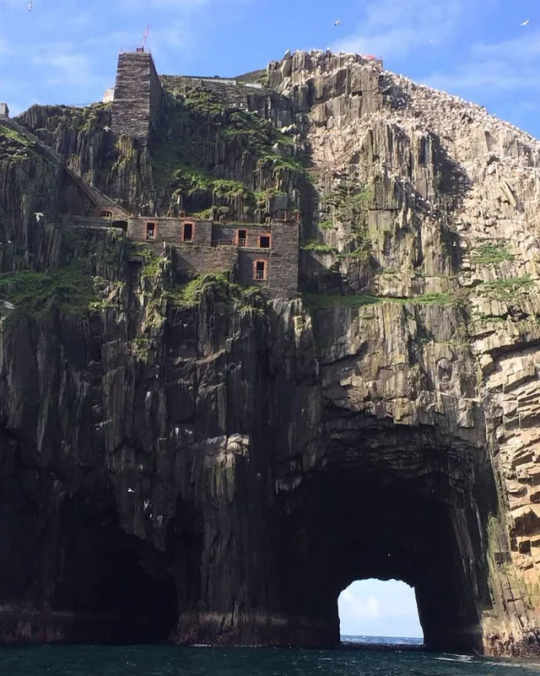
(Abandoned Buildings on Bull Rock)
What to Take Away From This
It is likely that pre-Christian belief in an afterlife where the soul of the departed traveled to Tech Duinn to be with an ancestorial figure known as Donn, where they stayed with him possibly before moving elsewhere to Hell in Metrical Dindshenchas or possibly under go a process of metempsychosis. This House of Donn was most likely reached through Bull's Rock in County Cork, a small island that resembles a Sidhe.
#donn#ceantar#na déithe#irish paganism#celtic paganism#gaelic paganism#ireland#mine#gaelpol#witchblr#pagan#celtic#Vimeo#resources
69 notes
·
View notes
Text
Article about a VR-based approach to Oidheadh Chloinne Tuireann, using a combination of Ogham script, old maps of Ireland, quotations from the text in Irish and English, and surrealist imagery, as the user inhabits the reincarnated body of the antihero/villain protagonist Brian, who seeks to understand why he died in his last life.
I don't endorse some of the statements re: pre-Christian beliefs...or about medieval Irish literature...BUT the point is that I think that this is a really cool approach to medieval Irish lit/specifically the mythological cycle.
(This project is only available thanks to a collaboration between digital humanities and Celtic Studies, if you want to help support more initiatives like this, if you haven't, please sign the petition here to support the Celtic Languages and Cultures programme at the University of Utrecht, which faces the loss of its BA program.)
8 notes
·
View notes
Text
I had a hypomanic episode at 3am and theorised an irish historical reading of Hoziers 'Foreigners God'
So while I listen to alot of variety while working, Hozier is a common part of my weekly background, and while I was researching for an article on wells in gaelic culture after going out and taking photos of local Sí mounds aswell, I feel like I got hit with the conspiracy theory beam that sent me into an epithany hyperfixation while listening to Foreigners God and how you can read it as a lament for the last millenia of irish history
The first verse talking about a romantacism of pre-christian, or specifically, pre-protestant plantation Ireland (before the Tudor conquest in 1536), given even early irish catholicism was by papl standards, basically pagan, as a wilder, more free place without the stigma enforced through religious and planter society ["She moved with shameless wonder. The perfect creature rarely seen"].
With the arrival of the english "liar brought the thunder", with the lie being able to maybe be read as the lie of "civilising us" ["Since some liar brought the thunder"]
In this, you could view the "She" as being an anthropomorphism of Éire, with the spirit of the people looking towards the author, either a singulr or collective representation of native irish, whos been continuously emptied out spiritually and culturally under colonialism, and now is filled with a growing hatred for not only the planters, but protestantism itself , even at personal cost ["But still my heart is heavy. With the hate of some other man's beliefs"]
The pre-chorus could be seen as a reinforcing of the scorn for the colonial planters, who especially in the 18th and 19th century, would have been mostly interacted with via the landlordism of wealthy protestant english aristocrats who maintained that their actions were justified in the name of "civilising" us, which would always hinge on violence ["Always a well dressed fraud. Who wouldn't spare the rod. Never for me"]
The second verse could be read as the most forward and lamenting, since it opens with the speaker rhetorically questiong their attempts at conforming to the heirarchy and imposed british way of life, and how often for the likes of peasant and working class irish, would mean performing the role of the simple, obediant but charming worker, to cling onto both employment and avoid potential backlash from the planter ["Wondering who I copy. Mustering some tender charm"].
The line returning to the state of Ireland and, assuming this vague time around the 1700's- early 1800's, our country had in essence been stripped of the majority of its natural and cultural resources, let alone any autonomy held by our people. And in that state of oppression, with minimal success in terms of organsed large scale revolution or uprising (e.g the 1798 uprising), Ireland could be read as having little hope of gaining freedom ["She feels no control of her body. She feels no safety in my arms"].
The last stanza of the verse could by far be the most emotional, especially for gaeilgeoirí, with the author lamenting his lack of language to express his pain for whats happened to the irish people. Explicitly, this could be read as being through the massive, systematic decline of Gaeilge. At the end of the 1700's, our population of ~5 million had estimated 3.5 million irish speakers. By 1851, following the famine, this had dropped to 1.5 million, and by 1900, only 600,000 remained on the island. This targeted attempt at cultural extermination had been going on for centuries, largely through the implimentation of Na Péindlíthe, or Penal Laws, specifically and extension of the staute of Kilkenny, which banned the use of irish when natives spoke to colonisers, and in 1851, banned any use of Gaeilge in areas under english rule. And any attempts to use or express our native language, music or culture was met with either legal, or often, violent rebuttal. All which you can read the author as expressing how with all that leaving them increasingly unable to truly express or show true love for the old Ireland that irish people and growing republicanism at the time wished to return to ["I've no language left to say it. But all I do is quake to her. Breaking if I try convey it. The broken love I make to her"]
It then just gets outright literal with the pre-chorus. English was and is not our language. The english cultural, historical and political weights placed on us were not ours. They were foreign words, and foreign ideals of a coloniser forced upon us ["All that I've been taught. And every word I've got. Is foreign to me"]
In no way saying is this valid or a well informed reading, but it was hard not to get sucked into the theorising and seeing serendipity betwen the sadness and loss in our history and the lyrics from one of our best musicians. Anyway. Hope if you enjoyed the mental ramblings if you got this far
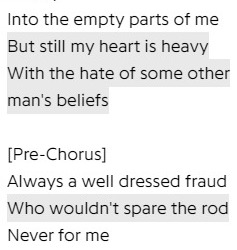

92 notes
·
View notes
Note
Hello! As an Irish reconstructionist, do you maybe know any specific traditions in celebrating Mean Geimhreadh (Alban Arthan?? Are these the same things??)
Ok, so for me personally this is a REALLY complicated question. I focus my reconstructionism on ~approximately~ Iron Age traditions (I feel this is an 'authentically' 'Celtic Irish' period being an age when there is abundant evidence of the Pre-Christian religion we know of as 'pagan Irish' being practiced and not yet being blended with Christian practices and beliefs).
So as such I don't do anything for Meán Geimhridh. That is not necessarily to say that the peoples of the Iron Age didn't recognize the long hours of darkness on this day, because I am certain they did, but that as far as the evidence that is available to us it was not something that held great religious importance. While the Stone Age religion being practiced seemed to place great importance on the solstices (marking them very clearly in the monolithic monuments and passage tombs they built) and later the dates held importance to the blended cultures of Irish/Scandinavian (yule) and Irish/Christian (Christmas), the period of time I focus on is oddly silent about these solar phenomenon. Apparently, only being noted by the classical writers as Alban Arthan.
However, even here there is a great level of debate. I subscribe to the theory that this particular description of religious activity was actually a case of mistaken identity and was actually speaking of, not the 'Keltoí' peoples, but the Germanic tribes further north (who we KNOW would have recognized this time of year and KNOW had a special religious connection with mistletoe). Furthermore, even IF this historical account WAS speaking of what we think of as the 'celtic' cultures it was obviously addressing an act preformed on the continent, which we know held similar but separate traditions from the insular 'Celts'.
Which brings us back to looking at any evidence for Pre-Christian/Post-Stone Age traditions that mark this time, and we do see some (just not in so much in Ireland). In the UK we see a widespread tradition at this time of year involving the Wren and straw boys, but as far as my research can tell it was likely spread through the UK in its Christian guise and any pagan roots it has are likely Welsh is origin.
Lastly, there is the widespread idea of the Mistletoe King and the Oak King.... this, in my opinion, is a jumbled fabrication of the pagan renaissance of the 1800s, and so while it can be considered 'traditional' at this point, holds no more historical weight then the Wiccan 'wheel of the year.'
At the end of the day, I don't hold any religious significance to the event BUT if I were to try doing something I felt was historically accurate I would keep a fire stoked, keep my family and friends close, eat and drink and share stories and songs to keep us all entertained as we enjoyed each others company (so the basic blueprint for any winter festival in most of the world 😅)
#Meán Geimhridh#Alban Arthan#ask#holidays#winter solstice#irish reconstructionist#irish reconstructionism#yule#Christmas
9 notes
·
View notes
Text
Somebody commented on my tattoo post saying the Triskelion was a Christian symbol invented by early Christian Celts in the 5th century. This is absolutely false and has no basis in any piece of reality.
The Triskelion, or Triskele, has origins for sure back to the Bronze Age. There is newer evidence coming out that it may actually go back further to the Neolithic Age. It can be found everywhere in Europe from the Mediterranean to the British Isles. It has strong associations with the Islands of Malta and Manx (specifically a triskelion with legs), and Ireland.
The Triskelion had such strong spiritual meaning to the people of modern day Ireland that when they converted Christianity, they associated the symbol with the holy Trinity. However, this association is weak, and instead the Triquetra was used much more often. The Triquetra still has heavy association with Irish Christianity.
This person also tried to invalidate my usage with The Morrigan by saying that it's mainstream usage with pagan deities is a modern invention by neopagans and reconstructionists. And my response is: that is completely true! Part of modern neopaganism is taking the scraps of pre-christian symbolism and spirituality we have and making something usable out of it. The association formally with The Morrigan is relatively new. However, it is an informed association. The Morrigan has always been associated with war and death, and the triskelion is still used in Ireland to denote patients who have died in hospital records.
In conclusion, the triskelion is a universal symbol in western culture (to the point where the United States Department of Transportation has a triskelion in their seal). Pagans have every right to use it.
10 notes
·
View notes
Text
Theories for Beast of Glenkildove. Spoilers from the demo and achievements list:
Cormac called the protagonist to lure them into a trap, possibly at the behest of another werewolf or a pack if he's been taken into one. How he feels about it and his willingness to do so depends on their relationship prior to Simon's death.
He's either an Ahroun or a Galliard; his tribe would depend on what contact he's had with other werewolves. I could see him being a Hart Warden based on his character in the opening chapters, but things have likely changed since then.
Áine is absolutely a supernatural but I'm struggling to clock her rn. Definitely not a vampire. Maybe a mage? If so, she or someone connected to her will introduce us to the Arcanum.
Imane turns out to be a hunter and she reps the Defence Drive because Áine is precluded from a Drive given the whole supernatural thing. Her whole deal seems to be keeping ordinary people away from danger.
We'll have a chance to kill Orla O'Donnell and everyone will clap - bonus points if Cormac does it.
Daniel's seemingly perfect life turns out to be anything but, and it turns out he's just as traumatised as everyone else. He's romanceable so a divorce arc seems likely.
He'll probably be the one whose in favour of killing Cormac because of their sometimes tenuous relationship (this is gut feelings based on some previous cog characters and stuff in the demo).
I can also see Claudia being in the Kill Cormac camp because he killed her brother, but she might also be in favour of saving him because its what Simon would want.
We get to kill Kitty's shitty fiancé - better yet, Kitty gets to kill her shitty fiancé.
Father Matt will be a Society of Leopold agent and probably one of our primary points of contact with the group along with Sister Judith.
Meaning he's absolutely in the Kill Cormac camp, but in a 'it's for his own good' way.
We'll get to visit Dublin. Also maybe get a Wonder Wally cameo if set before the end of Book of Hungry Names (he's a member of Broadbrook if you choose the Honour Ending).
Crom Cruach turns out to be the patron spirit of the Glenkildove pack (in reality he was a pagan god from pre-Christian Ireland associated with harvest. He was speculated by Christian writers to have been appeased/appealed to with sacrifices, which seems to be canonical in the World of Darkness based on the cave paintings. His worship was ended by Saint Patrick).
Mad Jack Dunbar turns out to have been a hunter who made a deal with a Bane, hence the 'devil worship' the cast talk about. Could show up as a formor, explaining that hunting wolves to extinction led to him hunting werewolves, taking his sport to a new extreme. I'd wager it's his lingering influence in the Wolf's Head that makes Cormac uncomfortable there.
Claudia's podcast will drop Easter eggs to previous and upcoming World of Darkness games from cog.
An author interview with William Brown confirms that the writers from Out for Blood and Parliament of Knives allowed him to borrow characters from those stories, and he did some collabing with Kyle Marquis as they were working on both games at the same time.
Out for Blood's Adam seems the most likely candidate to show up based on the achievements list. Chances are he'd be connected to Daniel, who is an investment banker, and as an experienced hunter, he acts as a sort of mentor for the group. Chances are he'd not get specific with what happened in Jericho Heights to avoid outright canonising anything beyond his survival.
As for Parliament of Knives, my tentative guess would be Lucca, who was often working overseas for Corliss - her knowledge of Dominate would probably be left to player interpretation rather than hard canonising her clan. As fun as Jordan would be as an alternative, they'd either have to canonise a gender for them or make them genderfluid to get around the fact they can be male or female in PoK, and I don't know how much leeway William would get on that from Jeffrey Dean.
(It'd be fun though, I think they deserve another cult)
And Nomi is likely to be the crossover character from Book of Hungry Names, and will probably appear in episodes of Claudia's podcast, as Cahoots is probably the collaborative aspect of their stories.
5 notes
·
View notes
Text
The Trolley Problem in SMTIVA and why I keep choosing Dagda

There are several ways one could analyze Danu and Dagda's philosophies (and in far more detail) but for this post I'll be talking in a simple and straightforward way through Pros & Cons with in-game evidence.
Personally, I see Bonds and Massacre's essential difference standing on 'I care for the now' and 'I care for a future with no suffering'.
-----Bonds-----
The price: - Dagda is replaced by a Dagda shaped by Danu - Humanity will continue to depend on religions thus the cycle of suffering continues for both humans and those who rely on human understanding (gods, angels, demons etc)
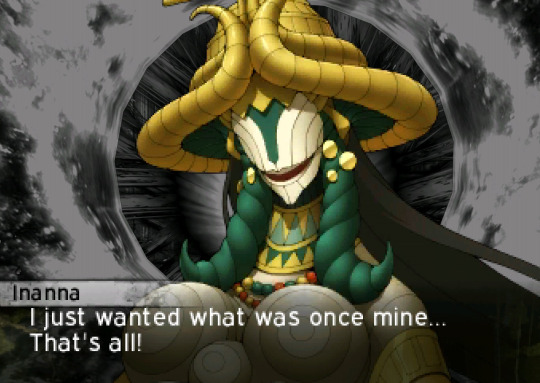
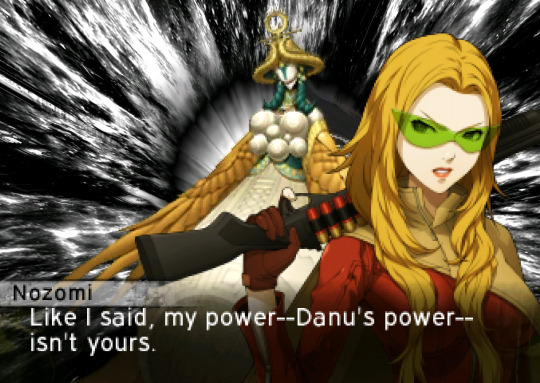
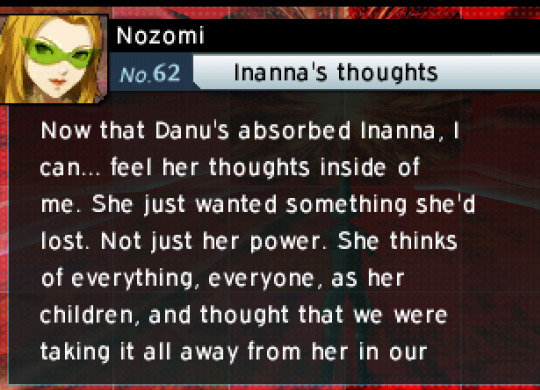






But you get! - The souls that were going to build the Cosmic Egg are set free - All of your teammates are alive with their sense of selves intact

It's an ending that favors the human side as it doesn't put the focus on blaming the humans but 'bad and tyrant' gods. Even though they become bad specifically from the observation done by humans.
Gods and demons will continue to exist by being observed and exploited and blamed on for their misery. But for Nanashi what matters is that his friends and allies are well and working together. For now.
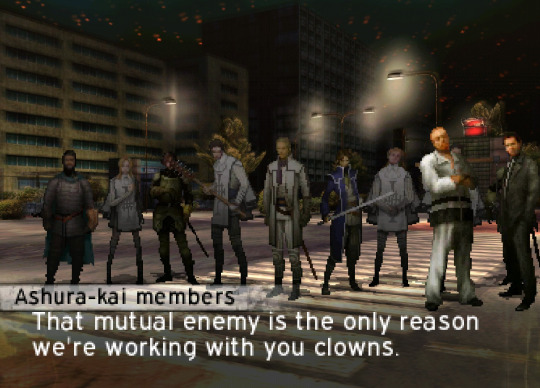
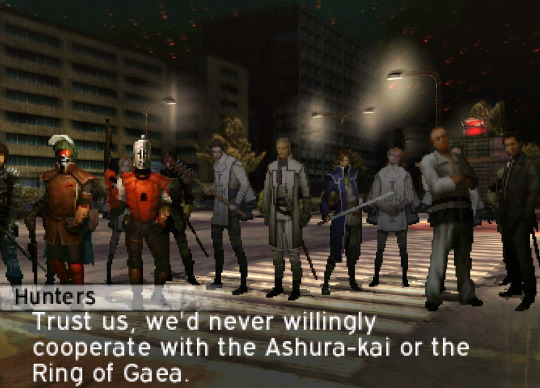
-----Massacre-----
The price: - Human souls will be sacrificed to build the new Universe - Your teammates are alongside the sacrificed and if revived, have a different sense of self

But you get! - Dagda stays as the original Dagda - Humanity will become independent and self-sufficient from religions, sets free those who rely on human understanding (gods, angels, demons etc)
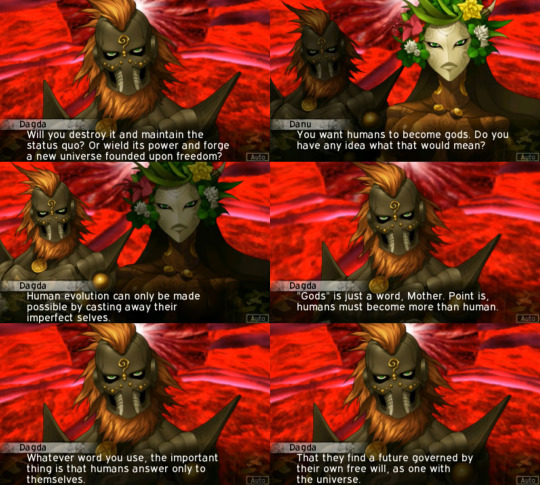

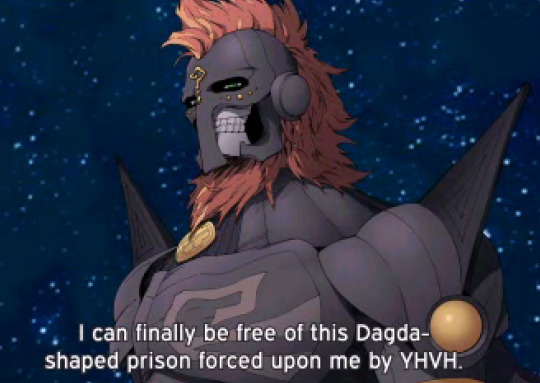

Here, Nanashi accepts solitude and taking on Dagda's god position for a future where religions and myths become pointless. No biases or influences that could twist the original nature of the world anymore so new humans will be born with unlimited potential of using the truth of the world for themselves instead of leaving it at the hands of deities. Unless an exterior force comes.

It's important to keep in mind that as cruel for his methods Dagda is considered, he doesn't favor a specific religion or way of thinking like how Law does and just wants Nanashi to avoid the root of his problems: the observation done by humans. To consider Nanashi as if he could be a second YHVH is to go against what Dagda is preaching for (and Dagda will still watch you as he disappears).
The best argument for this is shown in this summary from page 110 from the SMTIVA artbook (translated by dijeh):
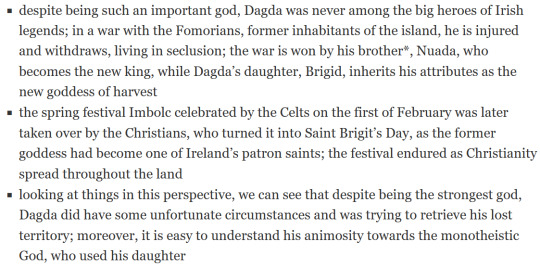
As sidenote, while Brigid isn't shown in the main story, she has a cameo in Tír na nÓg (aka the DLC area where Dagda makes it available for you to train), in which Nanashi can meet various Celtic figures from pre-Christian Ireland:

So if you are going to point out Dagda taking advantage of the mental state of Flynn and your Goddess, just scroll up and look again at what Danu does. They use the exact same method, with the real difference between them is that Danu's solution is an endless cycle of punishing and policing ideas that will keep being reborn from humans while Dagda wants to give future generations of humans the power to not depend on religions and on the same line, towards gods and demons the freedom of expectations to conform to what humans demand of them.
The irony is that Danu's kind and wholesome outcome favors way less groups in the long way than Dagda's despite the game constantly throwing at you that he is the most self-centered of the two.
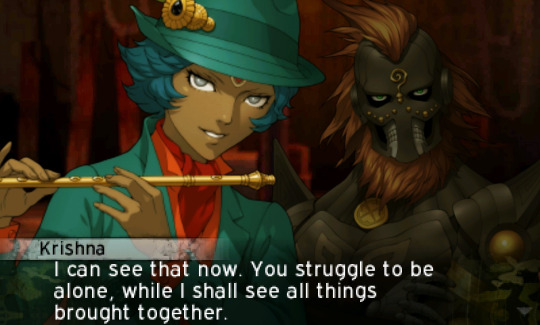
Krishna, the most fitting force to compete against Law and Chaos since hinduism is one of most popular religions (approx. 1.2 billion of adepts), advocates for the pagan religions to side with him so each gets its own slice of followers for a world order of polytheism instead of monotheism. It's an ending that favors deities associated to polytheism. Dagda does the opposite to Krishna: 1) uses the fact he is not a very well-known deity and hides in the Axiom from interference from other people and YHVH himself until he could meet someone with a powerful will as Nanashi so he can 2) force all deities and demons altogether to return to the nature.
Dagda's ending strips the powers and authority of all religions and gives them to humans.

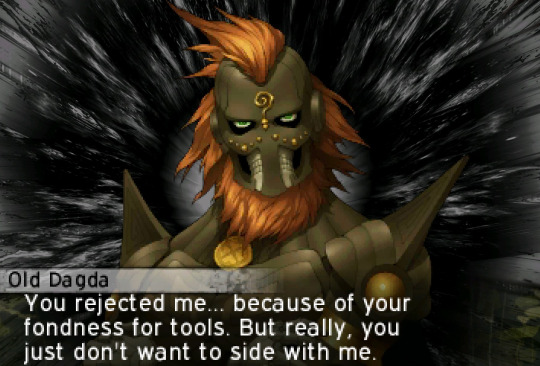
Now, obviously we also count that how a player considers the 'price' and the 'reward' will commonly vary from the theory (f. e. players picking a side for liking or disliking a character regardless of the meaning behind their alignment or viceversa).
In fact, SMTIVA validates this option as you can still see Nanashi being able to choose dialogue where he looks down on his teammates while also disagreeing with Dagda.
Meanwhile, Nanashi in Massacre is able to show compassion when parting ways with them as well.


In other words, there's no such a thing as a route where Nanashi is 'locked' into a single type of personality. Nanashi can canonically choose a route for ulterior reasons beyond what Dagda or Danu originally wanted them to be.
The duality of being friendly out of selfishness or being aloof out of not wanting to be heartbroken are all possibilities.

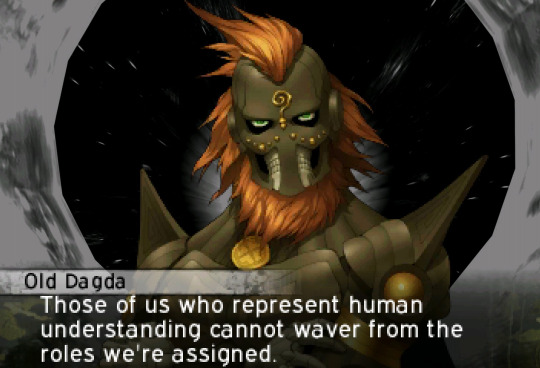
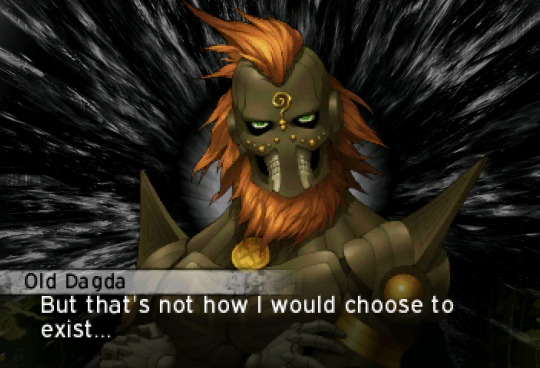
One could even say that the latter is present in Dagda himself, particularly from the ways you might be able to view his relationship and treatment of Nanashi.
To put it simply, the perspective of Dagda seeing a son in Nanashi after getting distanced from his daughter and Nanashi seeing a father in Dagda due to his orphan background and rather... unbalanced dynamic with Asahi and Boss.
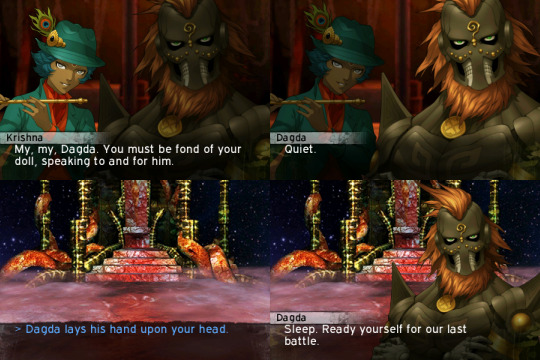
As how a certain quote goes, the opposite of love isn't hate, it's indifference. Taking into face value Dagda's grievances with influence caused by bonds with other people is similar to villifying the Chaos side without understanding the nuances of Law being what demonized it in the first place.
Dagda is intentionally made to be the bad apple of the game as a smokescreen for the player.
19 notes
·
View notes
Text
1st February
Bride’s Day
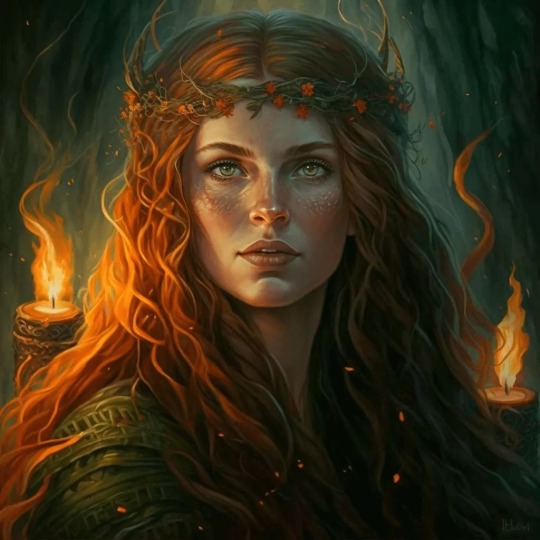
Brigid: A Multi-Faceted Goddess. Source: Celtic Native website
Today is St Bridget’s Day, but it is also the feast of the Celtic goddess Brigid, or Bride. Of the historical Bridget, little is known. She lived in Kildare, where she founded a nunnery and became its Abbess; she died in 525. However, after her subsequent canonisation, a number of miracles were attributed to her, including the ability to make cows produce more milk, and her turning an armful of rushes into fish during a fish scarcity. She was also, illogically, given she lived in the sixth century, supposedly Jesus’ midwife. Bridget took on a cultish status in Ireland, Wales and the Isle of Man. In central Wales a gathering of twenty nuns fiercely guarded an ever-burning fire dedicated to Bridget, which no man was permitted to approach. If all this sounds rather pagan, it is because it was. The Christian missionaries in the Celtic west encountered strong belief in the goddess Bride, who was associated with fertility, water and the spring. The winter fires set by the pre-Christian Celts in honour of Bride explain the saint’s fire cult, and her association with fertility and child birth, explains the Christian linking of Bridget to the birth of Christ.
A more specific tale concerning Bride and the return of spring was also told in pagan times. Bride was the daughter of the “Good God” Dagda, the god of plenty. In a similar tale to that of Hades and Persephone, Bride was said to have been kidnapped by Cailleach, the goddess of winter, who held her in a mountain fastness, forcing Dagda to withdraw his benevolence from the earth and enabling Cailleach to spread her sheet of ice all over the land for four months. However, the agreement with Dagda was that Bride should be released in early February, and on this, her feast day, the young goddess would emerge from her mountain prison, and the snow would melt as she stepped through it, bringing the light of spring in her wake. The people would set candles in their windows to welcome the waxing sun and placed a bed by their door to encourage Bride to enter their homes, bringing warmth and good fortune with her.
Inevitably, come the end of October, Bride had to return to Cailleach and her winter confinement.

#saint Bridget#brigid#bride#winter to spring#the enchanted world#time-life books#the book of Christmas#dagda#cailleach#pagan tales#celtic mythology
8 notes
·
View notes
Note
I’ve recently decided to research mythology of the British isles and I picked up a book about by an author called Geoffrey Ashe, and I’m wondering what red flags on the subject would be as five chapters in and it’s seems to focus on myths that are reflective British-Isrelism (eg mythical Scottish queen was a daughter of a pharaoh and alive at same time as Moses and a warrior Brutus is a descendant of Dan or lost tribe and an admiration of Robert graves, and I’m finding it very confusing and there’s talk about a great goddess or a triple one. For context I am a white ex Christian ? person deconstructing and interested in knowing about the pre Christian religions found in England Scotland, Wales and Ireland. So um yeah, while my main interest is Anglo Saxon paganism (that didn’t go so well) this book seems to be mixing them all together and it’s very odd. So um yeah, thanks for answering or reading um British mythology and folklore reflected imperialistic attitudes is something and it’s not adding up I guess.
I don't know enough about this topic specifically to write out a list of red flags, but it looks like you're off to a good start recognizing that admiring Robert Graves and connecting British figures to Egyptian royalty and Jewish figures are both sketchy as hell.
12 notes
·
View notes
Text
i am always taken aback by how little we know about the past. yes, we know about kings and battles and what the rich were up to, and where the borders were, but we know nothing about the poor. no one wrote about them, and so they might as well have not existed. this is brought to you by two things: firstly, a tiktok about a survey of random people on the street in london in 1851, asking them about general knowledge, and some specifics of christian theology, pre-public education being A Thing. and whilst generally they knew astonishingly little about everything ("the sun must be nearer, because it's warmer, right?"), in particular their lack of knowledge of christianity (fully not knowing who jesus was, beyond recognising the name) is fascinating to me. we think of the victorian era as being this conservative, god-fearing society, but that's the rich. the lower classes were... something. and we'll never know what that something is.
secondly, cumbric. brythonic languages stopped being spoke by the ruling class in england as early as the 6th century, and the people that continued to use them just sort of... disappeared into the historical record? along with almost all knowledge of what had existed pre-saxon takeover. yet there's evidence of cumbric (the language of northern england and southern scotland pre-anglicisation and pre-gaelicisation (i think i just invented a word) respectively) continuing to be spoken near the scottish border as late as the mid-13th century. that's an entire people who we know nothing of. for 700 years.
finally, irish travellers. we know nothing of how they came to be as a group (beyond genetic testing giving a vague date they diverge from the rest of ireland genetically, that is then contradicted by other evidence (the genetics say 17th century, but there are laws aimed specifically at nomadic peoples (similar to how there were laws aimed specifically at brythonic speaking peoples) that pre-date that (and yes that is basically the only way we know anything about lower classes historically, how they were discriminated against by law, which is fucking depressing), and unlike the britons, they're *still around.* that is a small, resilient ethnic group that is still around today that we have no clue how or when they appeared. that is insane. disclaimer: i am not an expert on any of this please do not blindly believe any of this, *especially* if it is contradicted by someone you know might actually know something. but yeah. i really hope that doesn't happen to us when this all goes kaputt one day. that future historians (excellent now i have both hamilton and enter shikari going round my head as well as the radiohead that was already there. sensible mix of things.) don't only know of the early 21st century through the Trumps, the Musks and the Bezos' of the world.
#3am ramble#why do i do this?#it's clearly not for other people lol#also yes this is extremely british
7 notes
·
View notes
Note
thank you for writing that! it was much appreciated and very informative. I wonder how you feel in regards to revivalist movements if there are any that are authentic in your perspective. are there any? While i wonder, i suppose it may end up being not for me to know. But i wonder all the same. Thank you again for posting your answer!!!
This is quite difficult to answer because there are many ways to interpret the question. Theologically, I of course do not view any form of revivalist polytheism as legitimate (I, like most Gaelic-speakers, am a devout Christian), but I assume you didn't ask me in that capacity.
Speaking as a Celticist and Gaelic folklorist, I do not think that any form of a 'Celtic' spirituality - and this includes notions of Celtic Christianity in the modern day, not just paganisms - are free from the issues I described there, and also I think that they run into the basic issue that we simply know extremely little about the pre-Christian religions of the Gaels and the Britons, to not even mention mainland European Celtic speakers. The only way to get to something like it is to both assume that Christian manuscript culture in Irish describes an accurate version of Gaelic pagan belief to the little extent that this is described, several hundred years after the last pagans converted, which even so gives us very little to work with to create something even vaguely similar.
Additionally, people that do this (sinnsearachd people, Gaelic reconstructionists, etc - I see you in my notes) that Gaelic Catholic practices and beliefs of the 19th century - almost 1500 years after conversion! - in Ireland and the Highlands are actually pagan, which again is deeply questionable and reflects Protestant assumptions about Catholicism in Britain and Ireland- which I hope I don't need to explain is rather horrid both historically and presently - as well as Anglo-colonial notions of the savage Gael as I described in the previous post. The idea that folklore gives you paganism is deeply questionable - there are some aspects of it that do have pre-Christian linkages, but this doesn't give you a complete religion, only a series of supernatural beliefs that have existed in harmony with Christianity for centuries.
Additionally, I think that the fact that so many people who are not Gaels by any defition, and who have no relationship with Gaelic culture or language, decide that they need to revive Gaelic polytheism specifically, rather than (say) North Germanic beliefs, that we actually know enough about that it can at least plausably be revived to some extent (although I don't know why you'd want to) reflects these fetishistic ideas about Celtic noble-savage-ism, not any authentic connection to the living and struggling culture of an actually existing people and is universally harmful to that people in the now.
I have serious political issues with Germanic revivals, which usually comes out of romantic ultranationalist rejections of Christianity as foreign to the body politic of Scandinavia or Germany, of Nietzschean rejections of Christianity as too Jewish and anti-Aryan (this I think has been absolutely fundamental to all forms of European neopaganism). I have similar political issues with Slavic revivals which are largely based on fabrications (most prominently the Book of Veles) by Nazi collaborationist Russian Whites.
If I were asked to say which ones are legitimate in the sense of representing continuity with pre-Christian beliefs, I'd say Sámi shamanism (although most Sámi are Christians, either Russian Orthodox or Lutherans, the nójadi survived into the 20th century and contemporary practitioners have direct links to them). I don't think any others have that.
I want to be very clear that this response is limited to the European neopagan revival movements that see the only ones I know anything about.
13 notes
·
View notes
Text
₊˚.✩🕯️°。⋆ Imbolc ⋆。°🕯️✩.˚₊
With the holiday coming up, I wanted to put together a personal research post for myself! If anything is incorrect please feel free to add on or send me an ask/ dm :D
⋆⋅☆⋅⋆ ───── ⋆⋅☆⋅⋆ ───── ⋆⋅☆⋅⋆ ───── ⋆⋅☆⋅⋆
Imbolc, celebrated February 1 to sunset on February 2nd, is a pagan holiday from Celtic tradition. It marks the halfway point between the winter solstice and spring equinox. Imbolc highlights the connections between seasons changing, and winter and sunlight.
The word “Imbolc” means “in the belly of the Mother” referring to the seeds of spring stirring in the earth. “Oimelc” means ewe’s milk. Around this time of year a lot of animals are giving birth to their first offspring of the year or heavily pregnant, as a result producing milk. This milk symbolizes the hope of spring.
─── ⋆⋅☆⋅⋆Origins and Traditions⋆⋅☆⋅⋆ ──
The celebration of Imbolc can be traced back to the pre-Christian British Isles. Its earliest mention can be found in 10 century Irish literature and poetry. The holiday traditionally aligned with the first day of spring and the idea with rebirth.
Traditional Imbolc celebrations were centered around the Celtic goddess Brigid, goddess of fertility, craft, poetry, and prophecy. She’s commonly associated with fire and milk. She was considered one of the most Celtic deities and appears throughout Irish poetry. She is also credited with the first keening, a traditional wailing done as a funeral practice in Ireland and Scotland.
Imbolc celebrations would traditionally start the night before February 1st where observers would prepare for a visit from Brigid by creating an effigy (sculpture) of the goddess, dressing her, and setting it in a basket overnight. The day of Imbolc was celebrated through rituals like burning lamps and bonfires in tribute to Brigid.
Over time Brigid was adopted into Christianity as St. Brigid. She’s become one of Ireland’s patron saints and is the patron saint specifically of nuns, newborns, midwives, dairy maids and cattle. She keeps the association with milk and fire as she was adopted into Christianity.
St. Brigid’s Day, celebrated on February 1st, replaced Imbolc. On that day an effigy of St. Brigid is washed in the ocean and surrounded with candles to dry. People also make Brigid crosses out of wheat as talismans.
Candlemas is a Christian holiday traditionally celebrated on February 2nd. It has commonalities with Imbolc. The celebration of the holiday can be traced back to 4th century Greece as a purification holiday and return of light after winter’s darkness.
⋆⋅☆⋅⋆ ───── ⋆⋅☆⋅⋆ ───── ⋆⋅☆⋅⋆ ───── ⋆⋅☆⋅⋆
Sources:
https://www.history.com/topics/holidays/imbolc
https://www.bpl.org/blogs/post/the-origins-and-practices-of-holidays-imbolc-setsubun-lunar-new-year/
2 notes
·
View notes
Text
Midsummer
Midsummer refers to the celebrations that originated in ancient times as a festival for the Summer Solstice, with both Christian and Pagan origins. Midsummer ranges from June 19th to June 24th and the Summer Solstice falls between June 20th and June 22nd, halfway through Midsummer celebrations. Every year, visitors from around the world gather at Stonehenge to watch the sun rise on the summer solstice.
Mysticism and magic are a common theme in Midsummer folklore across the world. Magic was thought to be strongest during the Summer Solstice and there are myths of the world turning upside down or the sun standing still at Midsummer. As Professor Ronald Hutton (University of Bristol) wrote, it was seen as “a time when the normal laws of nature or divinity could be suspended, when spirits and fairies could contact humans, when humans could exceed the usual limitations of their world.”
The Catholic church designated June 24th as the feast day of St. John the Baptist, to coincide with Midsummer. Bonfires are often lit on St. John’s Eve or Bonfire Night (as it’s known in Ireland) on June 23rd as a dual celebration of both Christian and Pagan events. Lighting bonfires on Midsummer’s Eve is a Pagan custom that pre-dates Christianity and is thought to bring good luck to lovers and ward off evil spirits.
Midsummer festivals are celebrated throughout Europe and the Summer Solstice is particularly important in Nordic communities, where seasonal changes in sunlight are dramatic. The Vikings used the long days to hunt, settle disputes, and conduct raids. In many Scandinavian countries, the Midsummer festival is a public holiday where it is known as St. Hans Day. In North America, Midsummer celebrations are derived from the cultures of immigrants who arrived from various European countries.
Midsummer was also the inspiration for one of Shakespeare’s most beloved plays – A Midsummer Night’s Dream – set in the woods, a powerful symbol of untamed nature, that explores how love makes us do strange things: “The course of true love never did run smooth.”
Midsummer is an important time of year in many Pagan and earth-based spiritual traditions. The specific traditions associated with Midsummer vary, depending on the culture but some common Pagan traditions include:
Lighting fires and candles to represent the power of the sun at its peak in Midsummer. People may also jump over the fire or pass through it to symbolize purification and renewal.
Dancing and music are performed around the bonfire or in other outdoor settings to celebrate the abundance of the season.
Gathering herbs. Midsummer is a time when plants are in full bloom, and many Pagan traditions include the gathering of medicinal or magical herbs for healing, divination, or ritual purposes.
Creating flower wreaths from specific flowers associated with the season or particular deities.
Honouring the fairy folk. Offerings are made to faeries or other nature spirits to honour their role in the natural world.
Overall, Midsummer is a time of celebration and connection to the natural world in many Pagan traditions. It represents the peak of the sun’s power, the abundance of the growing season, and is often celebrated with joy, music, and dancing. May the warm rays of the sun revitalize your spirit and bring you a fresh start. Happy Solstice!


6 notes
·
View notes